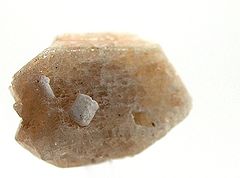Anorthoclase
| Anorthoclase | |
|---|---|

Doubly terminated anorthoclase crystal from Kinki Region, Honshu island, Japan (size: 1.3 x 0.9 x 0.7 cm)
|
|
| General | |
| Category | Feldspar |
|
Formula (repeating unit) |
(Na,K)AlSi3O8 |
| Strunz classification | 9.FA.30 |
| Crystal system | Triclinic |
| Crystal class | Pinacoidal (1) (same H-M symbol) |
| Space group | C1 |
| Unit cell | a = 8.28, b = 12.97 c = 7.15 [Å]; α = 91.05° β = 116.26°, γ = 90.15°; Z = 4 |
| Identification | |
| Color | Colorless, also white, pale creamy yellow, red, green |
| Crystal habit | Short prismatic crystals; tabular, rhombic, flattened along [010] |
| Twinning | Polysynthetic twinning produces a grid pattern on [100] |
| Cleavage | Perfect on [001], other partings |
| Fracture | Uneven |
| Tenacity | Brittle |
| Mohs scale hardness | 6 |
| Luster | Vitreous to pearly on cleavage planes |
| Streak | White |
| Diaphaneity | Transparent |
| Specific gravity | 2.57 - 2.60 |
| Optical properties | Biaxial (-) |
| Refractive index | nα = 1.519 - 1.529 nβ = 1.524 - 1.534 nγ = 1.527 - 1.536 |
| Birefringence | δ = 0.008 |
| 2V angle | Measured: 34° to 60° |
| References | |
The mineral anorthoclase ((Na,K)AlSi3O8) is a crystalline solid solution in the alkali feldspar series, in which the sodium-aluminium silicate member exists in larger proportion. It typically consists of between 10 and 36 percent of KAlSi3O8 and between 64 and 90 percent of NaAlSi3O8.
Anorthoclase is an intermediate member of the high albite – sanidine alkali feldspar solid solution series. Intermediate members of this series, high albite, anorthoclase and high sodium sanidine are stable at temperatures of 600 °C (1,112 °F) and above. Below 400 to 600 °C only very limited solution exists (less than about 5% on both the low albite and microcline ends). Anorthoclase and high albite exhibit triclinic symmetry, whereas sanidine and the low temperature orthoclase have monoclinic symmetry. If the high temperature intermediate composition alkali feldspars are allowed to cool slowly, exsolution occurs and a perthite structure results.
Anorthoclase occurs in high temperature sodium rich volcanic and hypabyssal (shallow intrusive) rocks. The mineral is typically found as a constituent of the fine grained matrix or as small phenocrysts which may occur as loose crystals in a weathered rock.
It was first described in 1885 for an occurrence on Pantelleria Island, Trapani Province, Sicily. The name is from the Greek αν, ορθός and κλάσις (not cleaving at right-angles), for its oblique cleavage.
...
Wikipedia
